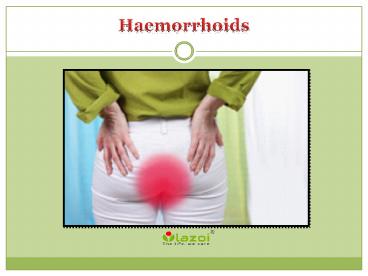Haemorrhoids: Symptoms, causes, diagnosis and treatment - PowerPoint PPT Presentation
Title:
Haemorrhoids: Symptoms, causes, diagnosis and treatment
Description:
Haemorrhoids, also known as piles, are swollen and inflamed veins in your anus and lower rectum. They may result from straining during bowel movements or from the increased pressure on these veins during pregnancy, among other causes. – PowerPoint PPT presentation
Number of Views:31
Title: Haemorrhoids: Symptoms, causes, diagnosis and treatment
1
Haemorrhoids
2
Haemorrhoids
- Haemorrhoids, also known as piles, are swollen
and inflamed veins in your anus and lower rectum.
They may result from straining during bowel
movements or from the increased pressure on these
veins during pregnancy, among other causes. There
are two types of haemorrhoids, internal and
external. Internal haemorrhoids develop within
the anus external haemorrhoids develop outside of
the anus. Of the two forms of haemorrhoids,
external haemorrhoids are the most common and
troublesome. Doctors are unsure as to what
leads to haemorrhoids. Various factors that could
play a part include - Straining during a bowel movement
3
Haemorrhoids
Continue
- Complications from chronic constipation
- Sitting on the toilet for a long time
- Pregnancy
- Family history of having haemorrhoids
- Anal intercourse
- Low-fibre diet
4
Symptoms
- Painless bleeding during bowel movements
- Itching or irritation in your anal region
- Pain or discomfortSwelling around your anus
- A lump near your anus, which may be sensitive or
painful - Leakage of faeces
- Symptoms of haemorrhoid usually depend on the
location. Since internal haemorrhoids lie inside
the rectum, you may not see or feel them because
they don't cause discomfort. External
haemorrhoids are under the skin around your anus.
When irritated, external haemorrhoids can itch or
bleed.
5
Tests and diagnosis of haemorrhoids
- If your doctor suspects you of haemorrhoids, he
may perform certain tests and procedures such as - Examination of your anal canal and rectum for
abnormalities where the doctor inserts a gloved,
lubricated finger into your rectum to feel for
anything unusual, such as growths. - Visual inspection of your anal canal and rectum
where the doctor examines the lower portion of
your colon and rectum with an anoscope,
proctoscope or sigmoidoscope. This enables the
doctor to look into your anus and rectum.
6
Treatments
- Most of the time treatment for haemorrhoids
involves lifestyle modifications. But sometimes
medications or surgical procedures are
necessary. Medications If your haemorrhoids
produce only mild discomfort, your doctor may
suggest over-the-counter creams, ointments or
pads. These products contain ingredients that can
relieve pain and itching. Minimally invasive
procedures If a blood clot has formed within an
external haemorrhoid, your doctor can remove the
clot with a simple incision. For painful
haemorrhoids, your doctor may suggest minimally
invasive procedures such as rubber band ligation,
sclerotherapy and coagulation.
7
Treatments
Continue
- Surgical methods If other procedures dont
produce positive results, your doctor may
recommend a surgical procedure. There are two
surgical procedures, (i) Haemorrhoid removal and
(ii) Haemorrhoid stapling.Eat high-fibre foods,
increase your water intake, avoid straining
during a bowel movement and you might be able to
prevent haemorrhoids.
8
CONNECT WITH US
- Logon to
- www.lazoi.com
- Like us on Facebook
- https//www.facebook.com/LazoiTheLife
- Follow us on Twitter
- https//www.twitter.com/lazoithelife
- Follow us on Pinterest
- https//www.in.pinterest.com/lazoithelife

